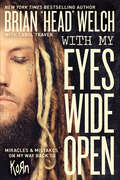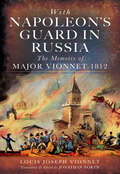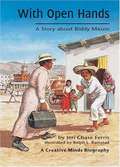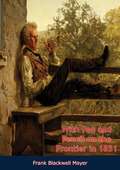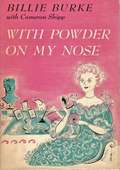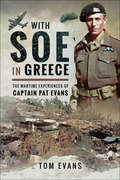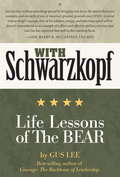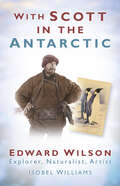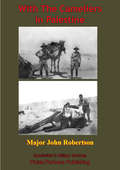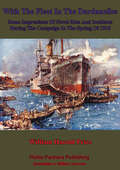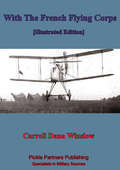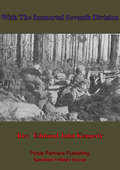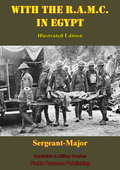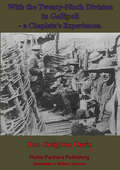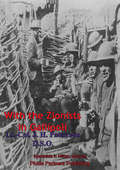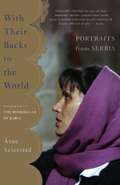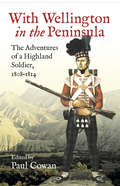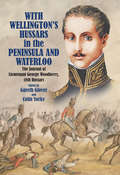- Table View
- List View
With My Eyes Wide Open: Miracles & Mistakes on My Way Back to KoRn
by Carol Traver Brian "Head" WelchHe left KoRn to help himself. He went back to help others. And along the way, he nearly lost everything.A life-changing spiritual awakening freed Brian &“Head&” Welch from a stranglehold of drugs and alcohol and prompted him to leave the highly successful nu-metal band KoRn in 2005. What followed was a decade-long trial by fire, from the perils of fathering a teen lost in depression and self-mutilation to the harsh realities of playing solo and surviving the shattering betrayal of a trusted friend. In this intensely inspiring redemption saga, perhaps most inspiring is Brian&’s radical decision to rejoin KoRn and reconcile with the tribe of people he once considered family in the metal music scene.Brian returned to his musical roots with a clear head and a devoted heart. Though his story is wild, hilarious, and deeply poignant, the message is simple: God will love you into the freedom of being yourself, as long as you keep the relationship going and never, ever quit.
With My Regiment From Aisne to La Bassée [Illustrated Edition]
by Arthur F. H. MillsIncludes the First World War Illustrations Pack - 73 battle plans and diagrams and 198 photosOriginally published under the pseudonym "Platoon Commander" these excellent memoirs were written by the noted novelist Arthur F. H. Mills after his service in the British Expeditionary Force in 1914-1915. "In the early summer of 1914, apparently unconcerned by the gathering storm and the colossal building of military might in Germany, the British regular army, reduced in numbers and not having fought a major conflict for over a decade, was at peace in its garrisons. When German troops marched through Belgium and attacked France, the British Expeditionary Force was hastily created and for British soldiers the transition from peace to mobilisation and transportation to the battle line happened within a matter of days. It is astonishing that the 'Contemptible Little Army' was not instantly enveloped by the advancing Germans who outnumbered them--often by much more than five to one. Some are jingoistic about the British Army of the day being 'the best army in the world,' however, the battle fought at Mons, the retreat to the Marne, the skilful command of the British staff and the dogged resistance of troops, who inflicted causalities on the enemy totally disproportionate to their strength, speaks for itself. The outcome was inevitable though and by the early months of 1915 the B. E. F. had all but been destroyed. Its tenacity had, however, earned the British sufficient time to build a new army, defence and response."-Print ed.
With Nails: The Film Diaries of Richard E. Grant
by Richard E. GrantThe star of the cult classic Withnail and I offers &“a refreshing combination of comedy, confession, and coruscation&” in this memoir of the movie business (Kirkus Reviews). Richard E. Grant&’s acting career has included memorable roles in some of Hollywood&’s most critically acclaimed films, including Robert Altman&’s Gosford Park and Francis Ford Coppola&’s Dracula. But he attributes his success to his first film role, starring as a flamboyantly pathetic Shakespearean in the underground hit Withnail and I. As Grant explains, &“I had no notion that, almost without exception, every film offered since would be the result of playing an alcoholic out-of-work actor.&” In With Nails, Grant shares his long, maddening, and immensely rewarding journey through the world of film. From the hell of making Hudson Hawk to befriending Steve Martin on the set of L.A. Story; and from eating spaghetti with the Coppolas, to window-shopping with Sharon Stone, and working with and learning from the best actors and directors in the business, Grant&’s unvarnished memoir &“is a biting and wonderfully funny look at the movie business by an actor who is as clear-eyed and observant about himself as he is about the craziness surrounding him&” (Publishers Weekly, starred review).
With Napoleon's Guard in Russia: The Memoirs of Major Vionnet, 1812
by Louis Joseph VionnetMajor Louis Joseph Vionnets memoirs of Napoleons disastrous 1812 campaign in Russia are readable, detailed, and full of personal anecdote and vivid glimpses into the life of the nineteenth-century soldier. His account concentrates in particular on the retreat from Moscow, but he was present at all the major actions and followed the entire course of the campaign from the opening moves in July 1812 to being chased through Prussia by bands of Cossacks in early 1813. He was present at the destruction of Smolensk, toured the battlefield of Borodino and witnessed the great fire in Moscow. Vionnet was a major in the Fusiliers-Grenadiers, a regiment of veterans in the Imperial Guard, and his account provides a wonderful insight into the lan, morale and cohesion of this elite fighting force. Jonathan North has translated Vionnets memoirs for the first time for this English edition. In addition to providing detailed explanatory notes, he quotes from the accounts left by five other soldiers from the same regiment, and these extracts allow the reader to follow the ups and downs of the unit as a whole. Louis Joseph Vionnet, Vicomte de Maringon, was born in Longueville in 1769, the son of a peasant and a lace maker. He joined the artillery in 1793 and was promoted to captain in the line in 1794. He fought in Italy in 1796, in the line infantry in 1798 and the Guard grenadiers in 1806, and campaigned in Prussia, Poland and Spain. In 1809, he joined the Fusiliers of the Guard, fought again in Spain in 1811 and then, with the rank of major, he took part in the 1812 Russian campaign, which he survived. He retired in the 1830s and died in 1834.
With One Shot: Family Murder and a Search for Justice
by Dorothy Marcic“A rapid-fire, real-life thriller.”—New York Times bestselling author M. William Phelps The lovely widow had confessed to the coldblooded murder of her husband. But Dorothy Marcic suspected a more sinister tale at the heart of her beloved uncle’s violent death. The brutal murder of LaVerne Stordock, a respected family man and former police detective, shocked his Wisconsin community. On the surface, the case seemed closed with the confession of Stordock’s wife, Suzanne. But the trail of secrets and lies that began with his death did not end with his widow’s insanity plea. Dorothy Marcic, a playwright, theatrical producer, and university professor, couldn’t put her doubts to rest. In 2014 she embarked on a two-year mission to uncover the truth. In the bestselling tradition of Ann Rule and M. William Phelps, With One Shot weaves a spellbinding tale of unmet justice and the truth behind a shocking family tragedy. “A riveting, personal story of the American justice system.”—Kaylie Jones, author of Lies My Mother Never Told Me “A gripping tale, well worth reading.”—Lawrence M. Miller, author of The Lean Coach “Marcic excavates new depths of perfidy, cruelty and lies.”—Randy Cohen, former Ethicist for The New York Times“A compelling read about a true family murder mystery marked by intrigue, betrayal and injustice.” —Leslie J. Mann, assistant prosecutor, Essex County, New Jersey
With Open Hands: A Story about Biddy Mason
by Jeri Chase FerrisRecounts the life of Biddy Mason, a slave who found freedom in California in 1856, who practiced the philosophy of sharing as she nursed the sick, delivered babies, and started many philanthropic projects after becoming a wealthy landowner in Los Angeles.
With Patience and Fortitude: A Memoir
by Christine QuinnChristine Quinn, candidate for mayor of New York City, is the first female and first openly LGBT Speaker of the New York City Council. In her memoir, With Patience and Fortitude, she shares the inspiring story of her life, her career, and the city she loves.Speaker Quinn talks about growing up in a middle-class, Irish family and describes the people and events that have shaped who she is and the beliefs she has dedicated her life to fight for. After her mother died when Christine was 16 years old, she began carving her own path, setting her sights on work that would make a difference in the world. Yet she would ultimately have to face coming of age in a world where both women and gay people had no choice but to fight for their dreams.Over time, she met those challenges both personal and professional with patience and with fortitude. Christine Quinn’s memoir includes original black-and-white photos from her personal archive.
With Pen and Pencil on the Frontier in 1851: The Diary And Sketches Of Frank Blackwell Mayer
by Frank Blackwell MayerFrank B. Mayer, a Baltimore artist, journeyed to Traverse de Sioux and Mendota on the Minnesota frontier in 1851 to record meetings between United States officials and Indian tribes who were ceding title to much of Southern Minnesota and portions of Iowa and Dakota. This volume contains the journal entries and sketches Mayer made on his travels. They provide a descriptive and visual record of Native American life as he saw it, particularly among the Sioux. Mayer includes sketches of lacrosse, child rearing practices, smoking the peace pipe, buffalo dancers, teepees and summer lodges, and portraits of prominent chieftains. There are also sketches of voyageurs and a variety of artifacts and military personalities connected with this chapter of Minnesota history. The materials in this book have been selected from larger holdings at the Newberry Library and do not illustrate the actual treaty signings. Mayer himself acquired a distinguished reputation as an artist and writer. Several of his paintings adorn the Maryland statehouse, and he wrote a number of illustrated articles for Harper's and Scribner's magazines.
With Powder on My Nose
by Billie Burke Cameron ShippFollowing on from her successful 1949 memoir "With a Feather on My Nose," here we have a further biography, first published in 1959, from famous Broadway and early silent film actress Billie Burke, best known as Glinda the Good Witch of the North in The Wizard of Oz and widow of Broadway producer Florenz Ziegfeld of Ziegfeld Follies fame.Co-author Cameron Shipp, a ghost writer who had also worked with Mack Sennett and Lionel Barrymore, assisted in assembling Miss Burke's copious notes and transcribed her enthusiastic monologues into this wonderful biography filled with good-humoured advice on marriage, career, exercise, food (included are some delicious recipes!), and even perfecting the art of lying about your age!A most enjoyable trip down a career film star's memory lane.
With SOE in Greece: The Wartime Experiences of Captain Pat Evans
by Tom EvansPat Evans parachuted into German-occupied Northern Greece in September 1943. His mission as a SOE operative was to support the Greek resistance movement, carry out sabotage and commando operations and gather military intelligence.By this time Greece was not only a country ravaged by a brutal occupation but being torn apart by fending political factions on the edge of civil war. Evans had to walk a tight-rope between the Germans, the Communist directed ELAS, Macedonia irredentists and his own SOE masters in Cairo and Allied High Command.After the Nazis withdrew in late 1944, he was sent to Northern Greece to try and restore some form of normality amid the chaos of civil war. His success can be measured by the warmth in which the locals still remember him, over 70 years on.This book draws on a wide range of sources, including SOE and War Cabinet papers but it is Pat Evans unpublished letters and reports that give the reader an insight into the challenge that he faced, both operationally and politically.The result is a thrilling and informative book.
With Schwarzkopf
by Gus LeeWith Schwarzkopf is Gus Lee's remembrance of his mentor and friend H. Norman Schwarzkopf, and his firsthand account of how Schwarzkopf shaped his life. In 1966, Lee, a junior-year cadet at West Point, was bright, athletic, and popular. He was also on the verge of getting kicked out. Nearing the bottom of his class due to his penchant for playing poker and reading recreationally instead of studying engineering, he was assigned a new professor: then-Major Norman Schwarzkopf. Schwarzkopf's deeply principled nature and fierce personality took hold of the wayward cadet, and the two began meeting regularly and discussing what it meant to be a scholar, a soldier, and a man. Lee's vibrant, witty narrative brings his more than forty-year relationship with Schwarzkopf to life. Readers get an inside look at West Point culture; they see Schwarzkopf's bristling anger with his rebellious pupil as well as his tenacity, intellect, and moments of surprising emotional warmth; and they watch as Lee starts to absorb his teachings. As he left West Point and took on more professional and personal roles, Lee approached every crisis or difficult decision by channeling his mentor. Over the years, Schwarzkopf's instilled values, wise counsel, and warm conversations shaped Lee and brought the two together in an unlikely friendship. In With Schwarzkopf, Lee passes along the lessons he learned so future generations can hear Schwarzkopf's important teachings.
With Scott in the Antarctic: Edward Wilson: Explorer, Naturalist, Artist
by Isobel WilliamsEdward Wilson (1872-1912) accompanied Robert Falcon Scott on both his celebrated Antarctic voyages: the Discovery Expedition of 1901-1904 and the Terra Nova Expedition of 1910-1913. Wilson served as Junior Surgeon and Zoologist on Discovery and, on this expedition, with Scott and Ernest Shackleton he set a new Furthest South on 30 December 1902. He was Chief of Scientific Staff on the Terra Nova Expedition and reached the South Pole with Scott, Lawrence Oates, Henry Robertson Bowers and Edgar Evans on 18 January 1912, arriving there four weeks after the Norwegian explorer Roald Amundsen. Wilson and his four companions died on the return journey. Trained as a physician, Wilson was also a skilled artist. His drawings and paintings lavishly illustrated both expeditions. He was the last major exploration artist; technological developments in the field of photography were soon to make cameras practical as a way of recording journeys into the unknown. This biography, the first full account of the Antarctic hero, traces his life from childhood to his tragic death.
With The Cameliers In Palestine
by Major James Robertson"Major Robertson is doing a great service to his old comrades in publishing this History of the New Zealand Companies of the Camel Corps. In New Zealand as in Australia, it is only natural that more interest has been shown in the Western theatre of the Great War than in the Eastern theatres as the great bulk of their soldiers served in the former. The Palestine campaign is consequently little known in these countries. Nevertheless, that campaign has been more used as a "text book" for the examination of officers in the British Army than any other phase of the Great War. In fact it bids fair to take the place of Stonewall Jackson's campaign in the Shenandoah Valley which had been used for this purpose for several generations before the Great War. In spite of the fact that no American troops fought in Palestine, Lord Allenby's campaign is better known in the United States Army, particularly in the cavalry, than it is in Australia and New Zealand whose troops played such an important part in it."Owing to its extreme mobility and suitability for desert warfare, The Imperial Camel Corps Brigade had many and varied roles to fill, all of which were filled with credit to the brigade and its gallant leader. The map of Egypt and the Sinai Peninsula is better known to its members than to any other troops. In Palestine where there is little desert, the particular value of their camels largely disappeared, but the brigade held its own with the cavalry in the fighting round Beersheba, the pursuit up the Philistine Plain, and the raid on Amman. After their transformation to cavalry, as the 14th and 15th Australian Light Horse Regiments and the 2nd New Zealand Machine Gun Squadron, the Australian and New Zealand "Cameliers" well upheld their traditions in the Battle of Megiddo and the advance on, and capture of, Damascus."-Introduction
With The Fleet In The Dardanelles, Some Impressions Of Naval Men And Incidents During The Campaign In The Spring Of 1915
by William Harold. D. Price Sir Everard Fraser K. C. M. G.As warfare ground to a halt in the static, bloody trenches of the Western Front in 1914, the Allied command sought to lever Germany's Turkish allies out of the war. Although the British had but a small standing peacetime army, she possessed the largest fleet in the world, and planned to use the awesome power of her huge naval guns to blast a passage through the Turkish defences of the strait. Constantinople would thereby be threatened and Turkey forced to sue for peace. The plan was bold, ambitious and doomed to fail.As the confident fleet steamed up through the Mediterranean, Padre Price kept a diary of his experiences and anecdotes of the Jolly Tars. However, his notes are filled with danger and bloodshed as the fleet encounter the brave and stubborn shore batteries, taking its baptism of fire. Though gallant and bloodied by the shells of the enemy, the fleet could not force the passage - a fateful failure that would lead to the landings at Gallipoli and further allied failures. Author -- Price, William Harold. D. 1917Preface -- Sir Everard Fraser K.C.M.G. (1859-1922)Text taken, whole and complete, from the edition published in London, A. Melrose, ltd. 1915Original Page Count - xvi and 124 pages.Illustrations -- 6 Illustrations.
With The French Flying Corps [Illustrated Edition]
by Carroll Dana Winslow"Petite bleu to pilote-a young American's flight into warThe author of this book, Dana Winslow, was a young American in Paris as France recruited men to fight the invading German forces of the Kaiser at the outbreak of the First World War. Feeling strongly for the plight and cause of the French, he immediately went to Les Invalides and there enlisted in the French Flying Corps as a trainee pilot. This vital first hand account is an essential source work of the period which reveals the training of the earliest French military aviators of the great conflict on the Western Front and it follows Winslow on his 'rite of passage' from inexperienced civilian, to lowly and little regarded aeronautical student (petit bleu) through his first perilous days in the combat zone to his time as an experienced and much prized pilote in the hostile skies over the trenches of the front lines. As may be expected, Winslow takes us to his war of dogfights, mid-air collisions, artillery spotting and reconnaissance in vivid-if humbly recounted-detail. Winslow's book is especially valuable as an insight into the variety of aircraft employed by the French during his time with them and he provides useful details as to their construction, abilities, applications and flying characteristics such-as those of the peculiar 'cut down' Bleriot that was 'the Penguin.' He also gives an interesting view of the business of military flying in wartime, which he distinguishes as entirely separate from piloting, as he describes it, as a mere 'conductor.' Accounts of battling in the air during the Great War are not common, so this volume is, of course, a welcome addition to their limited number and will be of interest to everyone interested in the subject."--Leonaur Print Version.Author -- Winslow, Carroll Dana.Text taken, whole and complete, from the edition published in New York, C. Scribner's sons, 1917.Original Page Count - xi and 226 pagesIllustration -- 15 illustrations.
With The Immortal Seventh Division
by Right Reverend the Lord Bishop of Winchester Rev Edmund John KennedyEven among the highly-trained and professional soldiers of the B.E.F in 1914 the men of the Seventh division stood apart for their bearing and training, for the contained no reservists; all were full-time soldiers. Accompanying these uncompromising men, was Reverend Kennedy, assigned to the 20th Brigade, which was to see much action during the opening months of the First World War.The Padré and his beloved soldiers trekked into Belgium to take part in the First Battle of Ypres, to find the local inhabitants welcoming but the atmosphere filled with apprehension. As the Seventh finally clashed with the invading Germans the author found his role turned from an observer to participant in offering comfort and even absolution to the wounded and dying. A man of committed faith he continued to minster to his men as they fought in the desperate action around Ypres.After a year with the troops the Reverend returned to England and composed his memoirs of the period but did not survive long enough to see their publication.Author -- Rev. Edmund John Kennedy d. 1915.Preface -- Right Reverend the Lord Bishop of Winchester.Text taken, whole and complete, from the edition published in London, Hodder and Stoughton, 1916.Original Page Count - x and 193 pages
With The R.A.M.C. In Egypt [Illustrated Edition]
by Sergt. MajorA veteran Non-Commissioned Officer tells of his experiences among the shells, wounded and diseases of the Egyptian Campaign of World War One. Includes 32 illustrations."THIS account of the work of the Royal Army Medical Corps in Egypt from the earliest days of the British Occupation in 1883 to the close of the Sinai Desert Campaign at the beginning of 1917, is in no way official, nor must it be regarded as in any sense officially inspired...It is due to the reader, however, to say at once that, though the book must be taken solely as the independent work of one man possessing no official status whatever, it has been produced under privilege, without which, indeed, it could never have been written. For the facts as to the doings of the R.A.M.C. on the battlefield, and in respect of the Corps' many activities in other branches of medical war service, the writer has been able to draw largely on his own experience, it having been his lot to serve as a member of the Royal Army Medical Corps both with the Dardanelles Army and with the Egyptian Expeditionary Force...Very few names are here set down, albeit many fine achievements and instances of singular devotion to duty have been necessarily recorded. Seeing that it was practically impossible to mention by name all in the Service who had won, or deserved to win, distinction, it was thought better to leave names alone altogether, and to let the great sum of heroism, enterprise, exertion, merge itself into the common honour of the Corps."
With The Twenty-Ninth Division In Gallipoli, A Chaplain's Experiences. [Illustrated Edition]
by Rev Creighton Oswin"The padre of the 86th Brigade, 29th Division, gives an account of his experiences at Gallipoli where he landed on 25th April 1915 to his evacuation on medical grounds on 12th August....it covers the period 27th January 1915, when he reported to the HQ of the newly formed 29th Division in Leamington, to 12th August 1915 when he arrived in Alexandria having been evacuated sick (diphtheria) from the Peninsula. The 86th Brigade was a Fusilier Brigade with 2nd Royal Fusiliers, 1st Lancashire Fusiliers, 1st Royal Munster Fusiliers and 1st Royal Dublin Fusiliers, and it was the first to land on 25th April 1915. It was with the first two mentioned that Creighton had most contact and they feature prominently in this account. The other two battalions, being recruited mainly from the south of Ireland, were predominantly RC.Creighton had come straight from civvy street and took a little while to find his feet among regular troops....This account is based on his diary and he took pains to write only what he got firsthand and from personal observation and he has tried to be as accurate as possible.The interesting photos were borrowed from the CO of 2nd RF and his narrative does give a feel for the conditions and fighting on the Peninsula. At one stage he gives vent to his feelings after a fruitless attack by a brigade of the newly arrived 52nd (Lowland) Division which cost over fifty percent casualties: "These things seem to happen every battle. The amount of unnecessary lives simply thrown away is appalling."...The book closes with a chapter by the BM, Major H.M. Farmar, on the landing of the 86th Brigade and the subsequent operations till 3rd May."N&M print versionAuthor -- Rev. Creighton Oswin, 1883-1918Text taken, whole and complete, from the edition published in London, Longmans, Green and co., 1916.Original Page Count - xiv and 191 pages.Illustrations -- 26 maps and Illustrations.
With The Zionists In Gallipoli
by Lt.-Col J. H. Patterson"Rare account by the C.O. of the Judeans - a unit of Jewish Zionists within the British army who helped drive the Ottoman Turks out of Palestine in 1917-18.This is an extraordinary account of one of the most unusual units ever to have fought in the ranks of the British army. 'The Judeans' were a battalion of Jewish soldiers raised during the Great War specifically to serve in Palestine, which, then as now, was a politically and racially sensitive area. Set against the background of the 1917 Balfour Declaration, which pledged British support for establishing a homeland for the Jewish people in Palestine, this is the account of the Judeans by its outspoken (non-Jewish) Commanding Officer, Col. J. H. Patterson, who is palpably proud of having led the Judeans, which he rightly describes as a 'unique unit' whose formation was 'unprecedented in our annals'...Patterson's account of the victorious 1918 campaign that swept the Turks out of what is now Israel, Palestine and Jordan, is shot through both with his pride in his men, when he goes as far as claiming that the campaign 'was actually pivoted on the sons of Israel who were once again fighting the enemy, not far from the spot where their forefathers had crossed the Jordan under Joshua'. Patterson is also - unusually, given the high degree of anti-Semitism then prevalent in Britain's officer class - highly critical of his fellow officers for discriminating against the Judeans, and other Jewish settlers in Palestine. This book is a rare insight into a remarkable episode in Anglo-Jewish history, and should interest anyone wishing to know more of the background to current conflicts in the Middle East. It is illustrated with 22 photographs of officers of the Judeans and Palestinian scenes, including Biblical sites."-N&M Print ed.
With Their Backs To The World: Portraits from Serbia - from the bestselling author of the Bookseller of Kabul
by Asne SeierstadFrom the bestselling author of THE BOOKSELLER OF KABUL comes a remarkable exploration of the lives of ordinary Serbs under the regime of Slobodan Milosevic-during the dramatic events leading up to his fall, and finally in the troubled years that have followed. Asne Seierstad traveled extensively through Serbia between 1999 and 2004, following the lives of people from across the political spectrum. Her moving and perceptive account follows nationalists, Titoists, Yugonostalgics, rock stars, fugitives and poets. Seierstad brings her acclaimed attention to detail to bear on the lives of those whom she encounters in With Their Backs to the World, as she creates a kaleidoscopic portrait of a nation made up of so many different-and often conflicting-hopes, dreams, and points of view.
With Their Backs To The World: Portraits from Serbia - from the bestselling author of the Bookseller of Kabul
by x Asne SeierstadFrom the bestselling author of THE BOOKSELLER OF KABUL comes a remarkable exploration of the lives of ordinary Serbs under the regime of Slobodan Milosevic-during the dramatic events leading up to his fall, and finally in the troubled years that have followed. Asne Seierstad traveled extensively through Serbia between 1999 and 2004, following the lives of people from across the political spectrum. Her moving and perceptive account follows nationalists, Titoists, Yugonostalgics, rock stars, fugitives and poets. Seierstad brings her acclaimed attention to detail to bear on the lives of those whom she encounters in With Their Backs to the World, as she creates a kaleidoscopic portrait of a nation made up of so many different-and often conflicting-hopes, dreams, and points of view.
With Their Backs to the World: Portraits from Serbia
by Asne SeierstadFrom the best-selling author of "The Bookseller of Kabul," an account of thirteen ordinary Serbian people and how their lives changed before, during, and after the fall of Milosevic
With Wellington in the Peninsula: The Adventures of a Highland Soldier, 1808–1814
by Paul CowanFew men from the 71st Highland Light Infantry who sailed from Cork with Wellington to Portugal in 1808 returned to the Irish port six years later. The author of Vicissitudes in the Life of a Scottish Soldier was one of the survivors and claims only four other men from his company came through the entire six years with him. As one of Wellington's elite Light Infantry units the 71st were in the fore of the fighting in some of the hardest fought battles of the Peninsular War. The book was controversial on its release in 1827 for its unvarnished and unsentimental account of the grim war against the French in Spain, the Netherlands, Portugal and France itself. A cynic with a highly developed sense of humour, the author was not afraid to criticise his superiors, be they thieving sergeants or officers who were far from gentlemen. Editor Paul Cowan draws on little known diaries and other accounts written by the author's contemporaries to corroborate and expand on this frank but all too long neglected first-hand picture of the war in the Peninsula as it was really fought.
With Wellington's Hussars in the Peninsula and Waterloo: The Journal of Lieutenant George Woodberry, 18th Hussars
by Gareth GloverGeorge Woodberry was commissioned into the 18th Light Dragoons (Hussars) as a cornet on 16 Jan 1812, and joined Wellingtons army as a lieutenant, seeing action in the key battles of 1813 and 14 Moralles, Vittoria, Nivelle, Nive, Orthes, Croix dOrade and the final battle of the war at Toulouse. He was wounded at Mendionde in a clash with French cavalry as Wellington advanced into France. He also served in the 1815 campaign, being at Waterloo and the march to Paris.What is most remarkable is that Woodberry found time to record events at length in his journal almost every single day. This enables the reader to trace accurately the movements of the 18th Hussars and Wellingtons army in general with precision. It also provides an insight into life on campaign in Spain, France and Belgium with the British Army of the early nineteenth centuryHis lively, detailed and entertaining account of his time in Wellingtons army is matched by the unusual story of the history of his journal. It was published once before, in 1898, but in French by a Paris-based publisher. The original journal, in two leather-bound volumes, has since been lost, but the French edition has now been translated back into English by renowned Napoleonic historian Gareth Glover and is published in the UK for the first time.
